All Management Events
- Data is the new oil: The Fundamentals of Linux and Data Analytics September 21, 2022
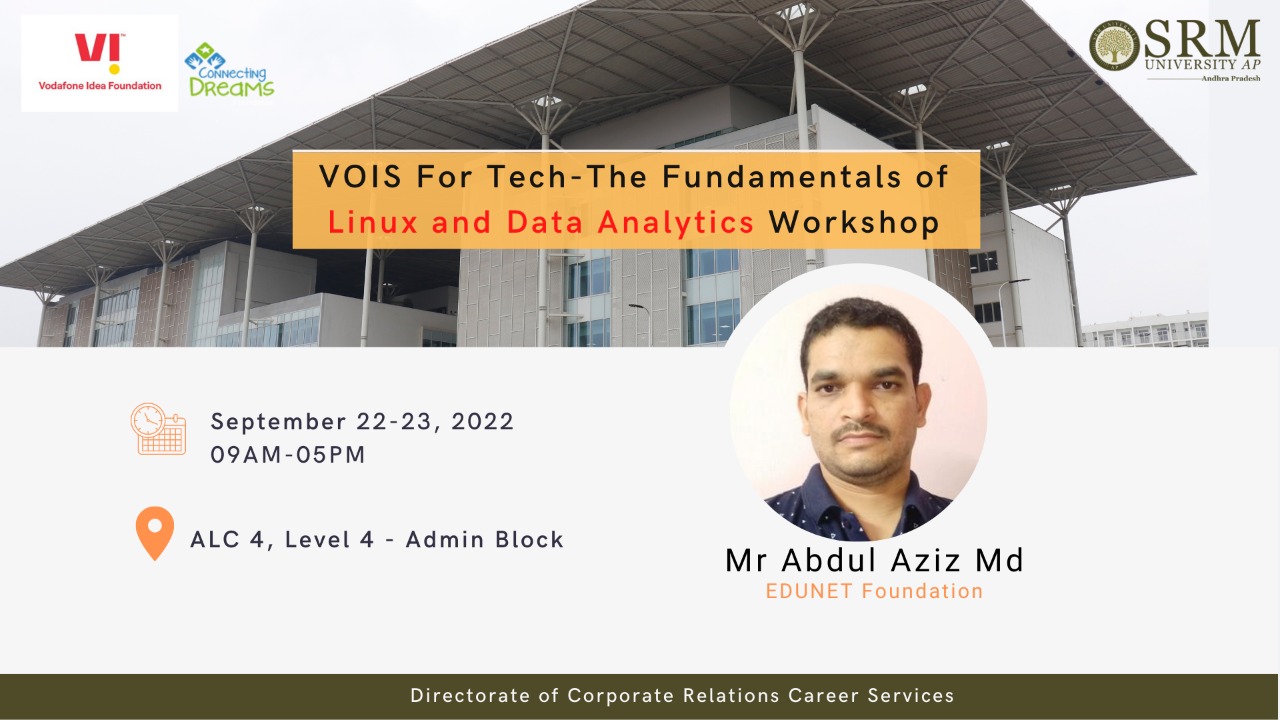 Connectivity and data are the substrata of the fourth industrial revolution. From tip to toe, the job market is data-driven and requires more IT support than ever. There is a massive demand for data analysts in the industry, and organisations hire them in bulk as they deal with data daily. The Directorate of Corporate Relations and Career Services is conducting a workshop VOIS for Tech- The Fundamentals of Linux and Data Analytics to discuss its various aspects. Mr Abdul Aziz Md from EDUNET Foundation will be guiding the workshop.
Connectivity and data are the substrata of the fourth industrial revolution. From tip to toe, the job market is data-driven and requires more IT support than ever. There is a massive demand for data analysts in the industry, and organisations hire them in bulk as they deal with data daily. The Directorate of Corporate Relations and Career Services is conducting a workshop VOIS for Tech- The Fundamentals of Linux and Data Analytics to discuss its various aspects. Mr Abdul Aziz Md from EDUNET Foundation will be guiding the workshop.Date: September 22&23, 2022
Time: 9.00 AM to 5.00 PM
Venue: ALC 4 Level 4 – Admin Block
About the speaker
Abdul Aziz Md joined EDUNET Foundation on March 2022 as a Master Trainer. He has completed an MTech in Artificial Intelligence from the University of Hyderabad, Hyderabad. He has 8+ years of experience in academics and research. His Areas of Interest are Artificial Intelligence, Machine Learning, Deep Learning, and Computer vision. He worked as an Assistant Professor at the CSE department of Rajiv Gandhi University of Knowledge Technologies (RGUKT), RK Valley campus, Andhra Pradesh, before starting his journey with the EDUNET Foundation.
Continue reading → - Navigate your tomorrow today: Education Fair 2022 September 21, 2022
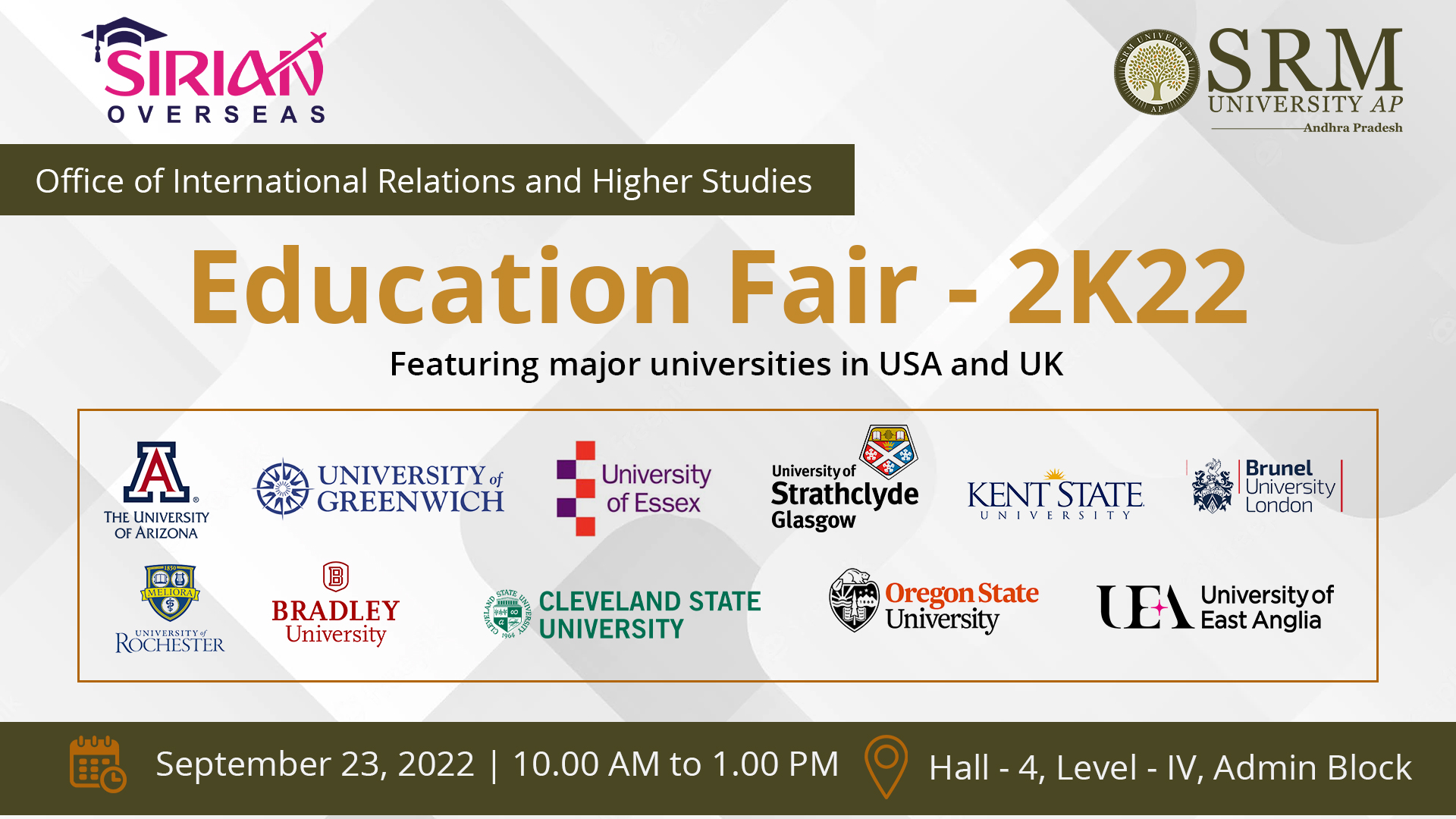 International education equips students with a broader worldview and firsthand experience of various cultures. It multiplies career opportunities and personal connections. Recognising the significance of higher education abroad isn’t enough; one must know how to get into the dream institution. The Office of International Relations and Higher Studies is yet again ready to assist students in navigating the different career options they will encounter in the higher education spectrum. Bringing the Education Fair 2022 to provide thorough guidance about the universities and programmes awaiting you across the globe.
International education equips students with a broader worldview and firsthand experience of various cultures. It multiplies career opportunities and personal connections. Recognising the significance of higher education abroad isn’t enough; one must know how to get into the dream institution. The Office of International Relations and Higher Studies is yet again ready to assist students in navigating the different career options they will encounter in the higher education spectrum. Bringing the Education Fair 2022 to provide thorough guidance about the universities and programmes awaiting you across the globe.Date: September 23, 2022
Time: 10.00 AM to 1.00 PM
Venue: Hall- 4, Level- IV, Admin Block
The Education Fair offers a golden chance to explore a diverse range of study programmes with our vast network of partner universities which can accommodate students from any educational background. Major USA and UK universities are participating in this greatly anticipated event. Highly experienced university representatives will be present on the occasion to pour light into the students’ higher education dreams.
Join the education fair and set the right direction for a better future!
Participating universities
• Bradley University – USA
• Cleveland State University – USA
• Oregon State University – USA
• Kent State University – USA
• University of Arizona – USA
• University of Rochester – USA
• University of Strathclyde Glasgow – UK
• University of Essex – UK
• Brunel University, London – UK
• University of East Anglia – UK
• University of Greenwich – UK
Continue reading → - Presented paper at the East Asian Economic Association Convention September 21, 2022
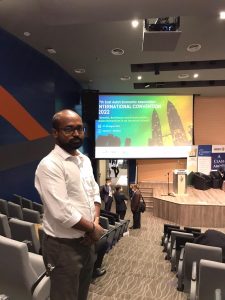
Dr J Vineesh Prakash, Assistant Professor, Department of Economics, presented a paper at the 17th East Asian Economic Association (EAEA) convention that was held on August 27-28, 2022 at Sunway University, Kuala Lumpur, Malaysia.The theme of the convention was “Growth, Resilience and Sustainability: Asian Dynamism in an Uncertain World”.
The East Asian Economic Association (EAEA) was founded in 1987 as the first international academic organisation devoted to East Asian economics. The international convention is its annual conference where papers for publication in the Asian Economic Journal are discussed.
Dr Vineesh presented the paper titled Does Business Group Affiliation Enhance Firm-Level Profitability? Evidence from Indian Automotive Component Industry, that addresses the growing competitive and volatile nature of economic sphere by testing the persistence of profit in a highly evolving emerging country environment such as India.
Emerging economies, such as India, confront different challenges than developed economies. The country has witnessed diverse regulatory environments, varying from highly regulated to more liberal ones. The more liberal environment coupled with the entry of overseas players into this realm has a definite impact on the existing industrial structure, thereby creating a volatile, ever evolving competitive environment.
The paper aims to address this issue and seeks to validate the part played by RBV in generating inimitable capabilities in a context-specific setting of a particular industry, i.e., the Indian automotive component industry. It also analyses the part played by business group affiliation in the post-reform era and its influence on profitability.
The paper found that profitability has moderate-to-high persistence and the variables, such as business group firms with overseas investments, export intensity, firm size, labour productivity growth, and past R&D intensity, have a contributory role in enhancing a firm’s profitability. Other variables such as business group affiliation, firm’s age, firm’s leverage, capital intensity, and A&M intensity have found to exercise a detrimental impact on the firm’s profitability.
Social implications of the research
The results, as reported in this paper, have some important implications for different stakeholders like managers, regulators, policymakers, etc. The finding that past R&D intensity has a positive influence on current profitability is significant to managers so they can allocate appropriate resources to fund such projects without many apprehensions.
The proof that labour productivity growth and profitability are positively related implies that managers could further focus on various in-house skill development programs to enhance labour productivity.
The finding of a positive influence of exports on profitability indicates that managers could further explore the external markets to boost up profitability as export markets are reportedly far more rewarding.
The discovery of moderate to high profit persistence has an important implication for regulators in order to facilitate healthier competition among firms. The moderate to high profitability persistence implies that the regulators have not managed to instill a reasonable level of competition in the industry through carefully crafted interventions, thereby facilitating its growth.
Continue reading → - How to write a compelling SOP and LOR? September 21, 2022
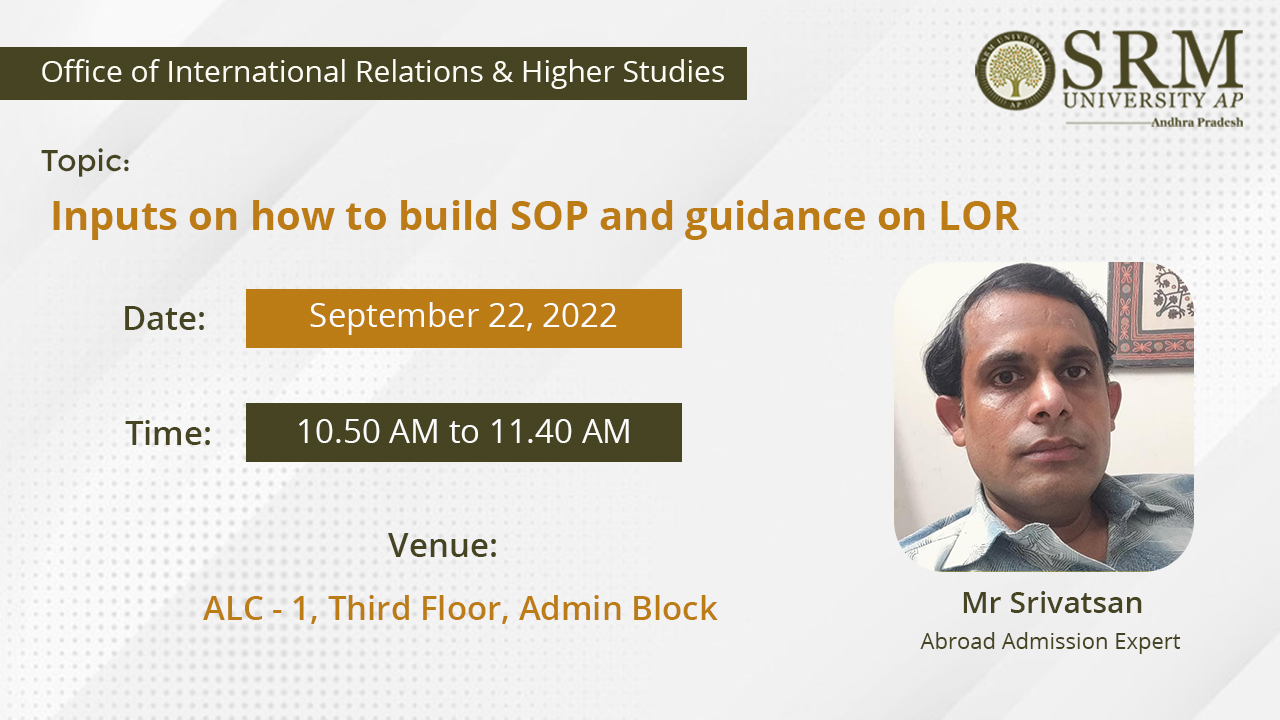
The Office of International Relations and Higher Studies is organising a webinar on “Inputs on how to build SOP and guidance on LOR” on September 22, 2022 from 10.50 am to 11.40 am. The session will be handled by Mr Srivatsan, an expert in abroad admissions.
Drafting a Statement of Purpose (SOP) and Letter of Recommendation (LOR) is an art. While an SOP is written on your own, an LOR is a letter that you receive from your teacher/professor. An SOP often follows a standardised format. There are several questions you need to answer in this document which will in turn reflect your real purpose in pursuing higher studies abroad. Most of the time, students lack clarity as to what they should emphasize in their SOPs. Proper guidance and assistance in this regard will help you address a lot of your queries.
Similarly, LOR writing also follows a pattern. There are different types of LORs such as Academic LOR, Professional LOR etc. Having a broader picture as to what aspects of your capabilities you wish to highlight will help your mentor to draft the letter accordingly.
In this session, a majority of your concerns regarding SOP and LOR writing will be addressed. The session intends to touch upon the various aspects associated with formatting these documents. Receiving the right guidance and tutoring will certainly help you draft a convincing SOP and credible LOR.
Speaker’s Profile
Mr Srivatsan is a Software Engineer by profession. He completed his Bachelor’s in Engineering with a major in Computer Science and pursued Master’s in Computer Science abroad at Wayne State University, Detroit. After a short dabble in Software Development and Testing with Microsoft, Mr Srivatsan returned to India having realised that his passion was teaching. He has been associated with Jamboree since 2014, after teaching Quantitative, Verbal, Aptitude, and Soft Skills. He has mentored a lot of students, placing some in Ivy League Schools. An avid Ultra Marathoner, he imparts the skills to his students to make sure they reach the heights they want.
- Edala Naveen climbing the success ladder September 20, 2022
 The moment he got the placement offer was surreal for Edala Naveen from the Department of Computer Science Engineering. Naveen was incredibly pleased with the opportunity. He has been placed at Crossover with an exciting offer of 44.91 LPA. He will be working at the company as an innovator to handle multiple technology stacks and develop projects and research work for use across the group of companies. He believes that his role in the company itself beckons interesting challenges and that he is in a well-poised position to make maximum use of it.
The moment he got the placement offer was surreal for Edala Naveen from the Department of Computer Science Engineering. Naveen was incredibly pleased with the opportunity. He has been placed at Crossover with an exciting offer of 44.91 LPA. He will be working at the company as an innovator to handle multiple technology stacks and develop projects and research work for use across the group of companies. He believes that his role in the company itself beckons interesting challenges and that he is in a well-poised position to make maximum use of it.The training he received from the university has largely been from the ISCP and ISES subjects. These subjects are beneficial in preparing for GRE and IELTS and thus helped him clear the assessments for the placement. He secured high scores for CSAT and GRE and aced IELTS with a score of 8.5 in 9. He could also crack the coding tests with the knowledge he earned from the ISCP classes at the university.
Naveen was in awe of the Next Tech Lab of the university, which was a robust support system for him throughout the process. “Not only did the student-run nature of the lab help me have a safe environment to fail faster, but it also helped me to maintain the sense of autonomy that ultimately provided me with the confidence to attempt and clear the role’s requirements,” he said.
He was impressed with the personnel and staff who had helped him by availing resources and knowledge when he reached out to them. The constant assistance from the Directorate of Corporate Relations and Career Services was a valuable addition to his preparation for the technical interviews. He conveyed his gratitude to his former professors; Dr Prateek from Screenwriting, Dr Anupama Ghattu from Teaching and Learning, and Dr Priyanka from Computer Organisation and Architecture. Their patience and welcoming learning environment allowed him to express and learn from his mistakes.
Naveen considers this placement an excellent stepping stone to launching a career. He aspires to continue his higher education alongside this job. In the near future, he wishes to gather the experience and technical skills necessary to give back to the community through education.
Continue reading → - Dr Kakumani K C Deepthi September 20, 2022
- Mental health of school students during the COVID-19 pandemic in India September 20, 2022
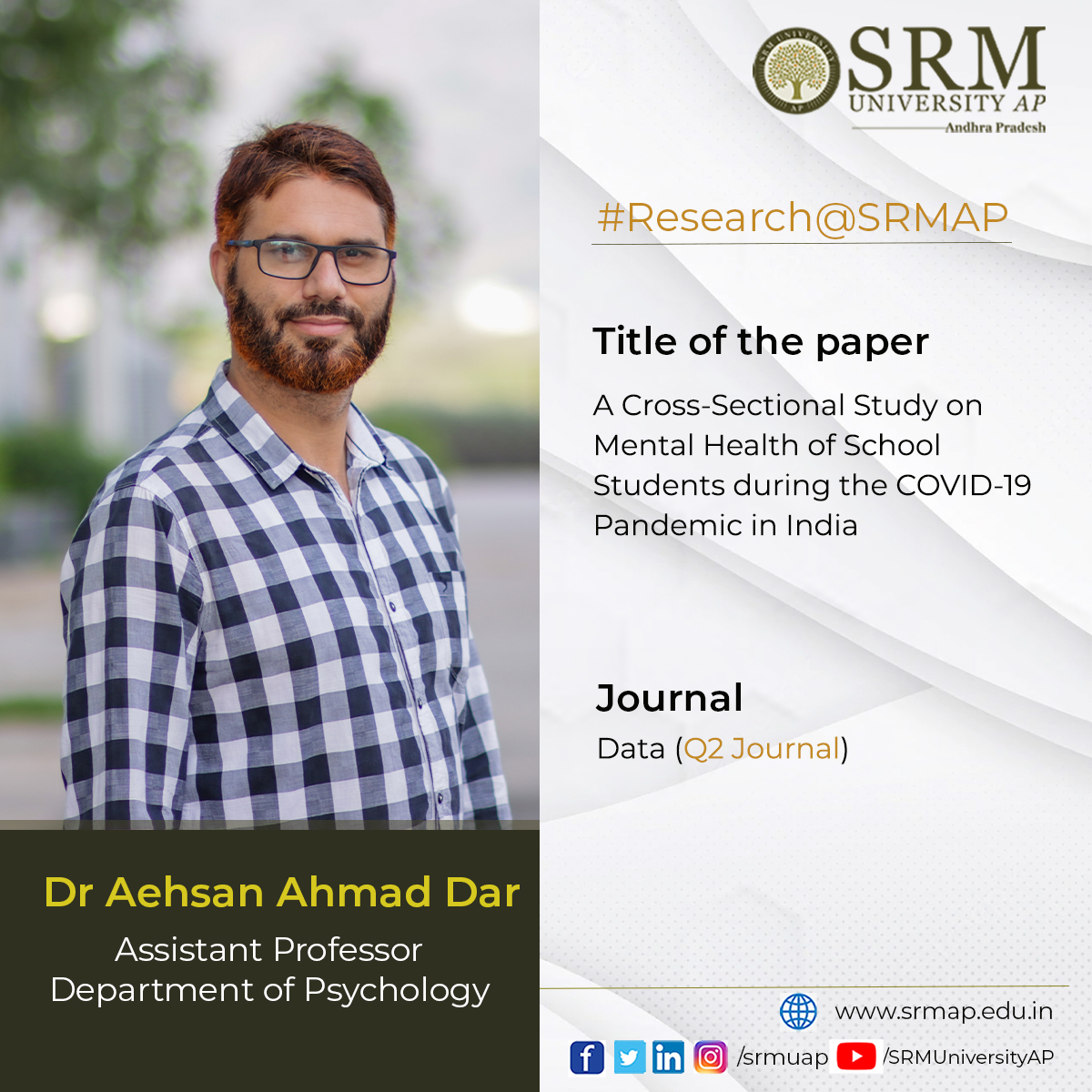
Dr Aehsan Ahmad Dar, Assistant Professor, Department of Psychology, published the article titled “A Cross-Sectional Study on Mental Health of School Students during the COVID-19 Pandemic in India” in the journal Data in collaboration with academicians from different universities across the country and abroad.
The present study estimated the mental health of school students during the COVID-19 pandemic. The findings revealed that the COVID-19 pandemic caused stress which increased the levels of anxiety and depression among the students. However, social support from family and friends was found to be a protective factor for mental health.
The findings of the research will serve as a reliable source of information for mental health professionals and policymakers to better understand the impact of the COVID-19 pandemic and other traumatic experiences on mental health. Therefore, necessary efforts are suggested to provide mental health support services to prevent the development of mental disorders.
Dr Aehsan’s future research plan is to study the mental health of youth and ascertain its risk and protective factors. About 19% of the world’s children live in India, which constitutes 42% of the total Indian population, and nearly half of these children are vulnerable and need care and protection. Due to various traumatic experiences, stress has increased among young people resulting in the development of various physical and mental disorders.
His research will focus on the pathogenic (posttraumatic stress disorder, depression, anxiety, somatization) and salutogenic (posttraumatic growth and resilience) consequences of trauma to help the youth withstand adverse experiences to develop psychological competence. The research will provide insights into the mental health status of youth that would be helpful for the administration, policymakers, and other voluntary organizations to understand effective ways to devise and implement the best intervention programs for maximizing mental health protective factors and minimizing its risk factors.
Continue reading → - Dr Deblina Dutta September 20, 2022
- Industry visit to Fopple Drone Tech Pvt Ltd September 20, 2022
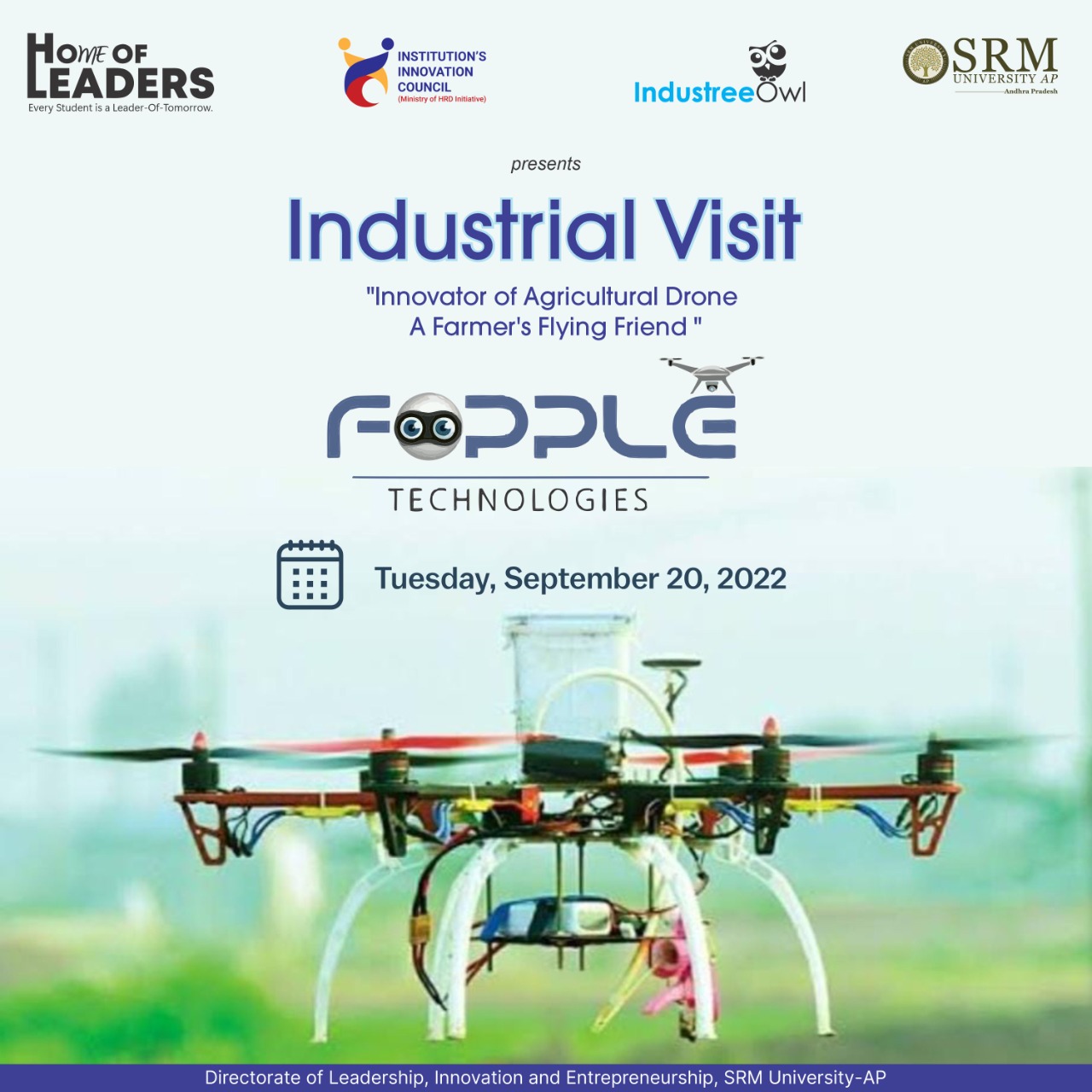
The Directorate of Entrepreneurship and Innovation is organising its first start-up visit to Fopple Drone Tech Pvt Ltd, a revolutionary agricultural machinery manufacturer in Andhra Pradesh. The programme is scheduled on September 20, 2022, under the leadership of the student community – Industree Owl. The visit will be flagged off by the honourable registrar Dr R Premkumar.
Industrial visit is an integral component of the active learning pedagogy offering students practical exposure in their field of studies. Observing the working culture of an industry from close quarters will help students keep abreast of the latest technologies, corporate strategies, and current trends, being followed in leading companies.
Fopple Drone Technologies, founded by Mr Ambula Gopi Raja, gave rise to the nation’s first agriculture drone. These drones spray fertilizers in a perfect manner as designed by the innovator. They can cover up to fifty acres of land in a single day. With a smaller number of farming labour available in the rural areas, such innovative accessories play a vital role in the sustenance of this dwindling tribe of farmers. In addition, they also save time and spray uniformly unlike humans. The business model of this start-up is unique.
The Directorate of Entrepreneurship and Innovation spares no effort in connecting students with industrial networks. Industrial visits are excellent opportunities to interact with business professionals and experts that may help them in building necessary leadership qualities and management skills.
Industree Owl is one of the student communities operating as part of the Home of Leaders, managed by the Entrepreneurship directorate. The community works with corporates and provides a platform to check the industry readiness of students via events like competitions, conferences, and hackathons. The tentative outcomes of the scheduled industrial visit are as follows.
- Practical exposure to a startup and the challenges – narration from the founder.
- Meeting the founder, his team and learning more about the assembling unit and the research lab.
- Experience the latest drone technology and the various applications in the industry.
- Opportunity to start a Drone Centre of Excellence at SRMAP
- Experience the real customers and the scope of the technology in India in the next 3-5 years
- Meeting the farmers on the field and understanding the true meaning of a “problem statement”.
- Design a solution and inspiration to start a project/ venture in the same domain.
- Introduction to hackathon: best practices September 19, 2022
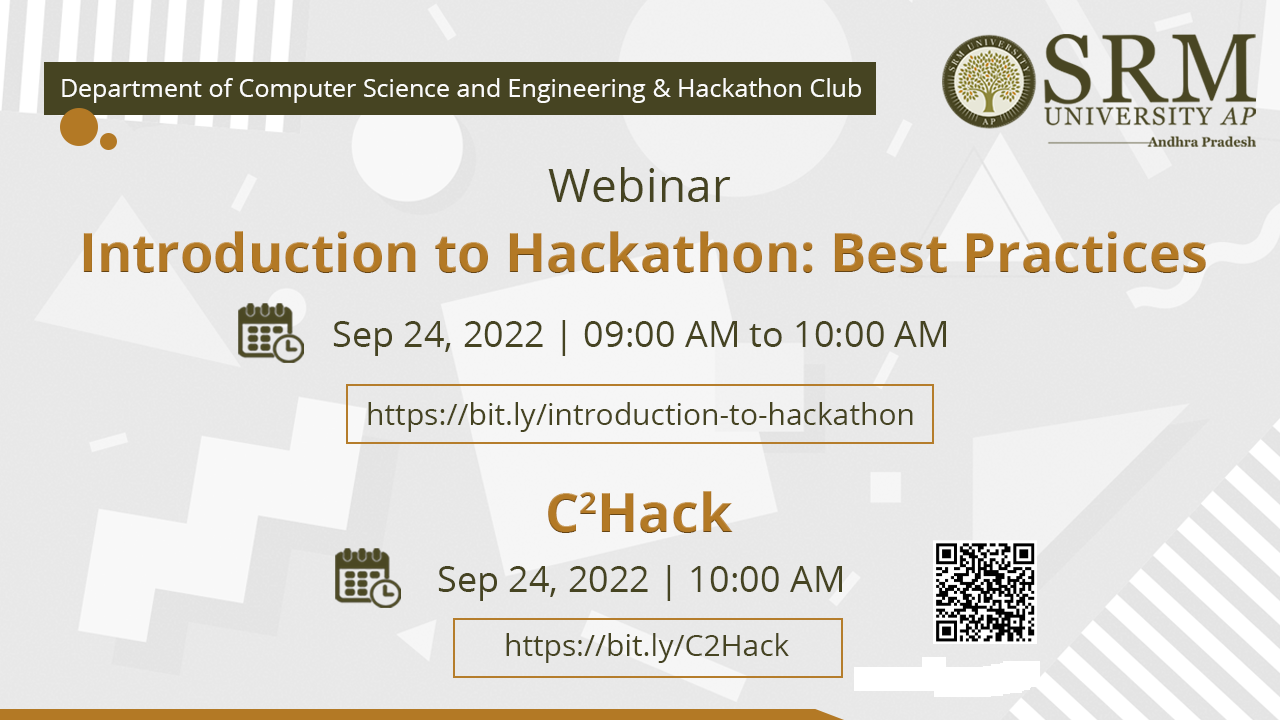
The Department of Computer Science and Engineering in association with the SRM AP Hackathon club is organising a webinar titled Introduction to Hackathon: Best Practices from 9 am to 10 am, followed by a 24-hour internal hackathon C2Hack at 10 am on September 24, 2022.
A hackathon is a social coding event bringing together computer programmers and other technology enthusiasts together to conceive a new software programme or redesign an existing programme to enhance its performance. Hackathons present a constructive platform for developing prototypes for various applications and programming languages or for providing solutions to real-life challenges ranging from educational technology to disaster management.
Hackathons are thus classified into different types based on their objectives and themes. Having a well-defined set of rules is a necessity while organising a hackathon. The webinar intends to introduce students to the fundamentals of hackathon and some of the effective practices one may follow while participating in a hackathon. Students will also be given the opportunity to test their hacking skills in an internal hackathon C2Hack following the session.
Join the webinar and learn how to use your tech genius to find solutions to the greatest of real-life challenges. Every hackathon is a smart route to actualise your ideas into innovations.
Continue reading →

